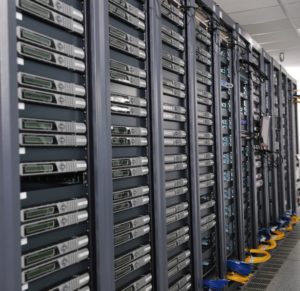A rack server is one of the most useful items in IT hardware, allowing you to store multiple servers in a space-saving rack structure. Server modules are stored in mounting slots called bays and can often hold between one and eight server units. Unlike tower racks that are designed to be stored in their own cabinets, a server rack has a lower profile that allows your servers to sit on a shelf, keeping them off the floor.
Rack servers are practical for their versatility, which allows them to be stacked, extended, and perhaps most importantly, networked. Let’s take a look at why rack servers have become such a standard accessory in IT hardware management.
Why Are Rack Servers Popular?
Rack servers are the workhorses of the IT world, used in companies of all sizes. And that’s not surprising. Rack servers can offer you many clear advantages over other server configurations, including:
-
Consolidated server and network control: Not only can you put all your server units in one place, but most rack servers offer the ability to install a network switch. And that’s an enormous time saver. Network managers can simply connect all the servers into a single switch to quickly bring the servers online.
-
Scalability: Need to upgrade? Need to add more server units? It’s not a problem with rack servers. Most units simply slide in the slot and are secured with screws. Reprogramming a unit or adding a new one can be a simple matter of getting out your screwdriver.
-
Convenience: Racks can be stored horizontally, with most racks allowing servers to be locked into a low, space-saving profile. Rack servers are easy to move and easy to position in tight spaces, even when server racks are stacked. However, it’s important to remember that the more server units get added to your server rack, the heavier, warmer and more power-intensive it will be. It’s important to have your rack server in a cool, low-dust environment. And keep in mind, the more server units you have, the more provisions you need to make for cooling equipment.
-
Compact: Each rack server fits neatly into a 19-inch by 1.75-inch enclosure. Each of those 1.75 inch-high rack units are abbreviated as U, with a typical full-size rack cage being 42U, and hardware typically measured in heights of 1U, 2U, 3U and 4U.
What Are the Components in a Rack Server?
While the capacity of all these components can vary widely depending on your data and computing needs, most individual rack servers contain these common components:
-
A motherboard—This single server board connects all the systems in your rack, and allows the components and data buses to communicate with each other.
-
A Central Processing Unit (CPU)—Also known as a processor for short. While a motherboard provides connections, it’s the CPU that allows you to set processes and issue instructions to the servers in your rack. Think of it as the thoughts that travel over the brain of your computer.
-
RAM (Random Access Memory)—This, in short, is the active data processing capacity of your server stack. Scale it up with more server units, or scale it down by taking them away. But the server racks with the most server memory slots will make it easy to upgrade your processing power for the future, without time-consuming reconfigurations.
-
A Host-Bus Adapter (HBA)—This simple item allows you to connect external devices to your server, such as networked storage.
-
I/O Ports—These ports are a whole subcategory unto themselves, and where you place them can have a big impact on your server design and functionality. Types of ports include USCs, serial ports or AUX ports. Which ones you choose will depend on your server size, use case and configuration.
-
Drive bays—Nearly every server rack configuration will have auxiliary drive bays included. This allows you to bring on more hard disc drives (HDDs) or solid State drives (SSDs) as your needs dictate.
-
Extra equipment—These are the little add ons that make your server stack easier to manage. Common items include rack rails, bars for corralling your cables, and a cooling system that keeps your server rack running healthy and strong.
What are Rack Servers Used For?
Rack servers make it possible for your IT operation to coordinate, protect, and store your data processing resources. When you mount your server units into a rack server, you create a network for your company that is scalable and manageable. Most organizations have dozens of rack servers, and some even have hundreds or more, all of them part of the same corporate network, and working to keep data operations humming.
Most rack servers are stationery and made from metal. However, in military installations, rack servers are designed to be portable for working in the field, and are designed with carrying cases, dust-proof shields, portable cooling equipment, rubberized bumpers, and other design elements that make it possible to keep their server systems on the go.
Either way, your rack server configuration is one of the most important IT management decisions you’ll make. Choose wisely!


